Rehabilitation Program: Visual Memory
Click to try FREE for 15-Days.
The exercises included in the module will help you to train visual memory using abstract symbols or exotic characters. It also helps pay attention to visual details.

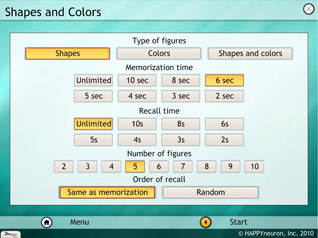

Shapes and Colors
The task
In this exercise, the patient has to memorize several figures of various shapes and colors and then recognize them among slightly different ones.
What it trains
Every day we encounter a myriad of different symbols and logos, including traffic signs, markers for shops and stores, even computer icons! This exercise demands attention to detail and the use of discrimination and differentiation for shapes. It calls upon the user's visual short-term memory. Visual short-term memory enables the brain to store visual information such as shapes and locations of objects. He then has to pay attention to details to discriminate the figures and build strategies in order to remember the ones he just has memorized.
Parameters
The parameters that can be selected are the type of figures (colors, shapes, or shapes and colors), the memorization time (unlimited, 10, 8, 6, 5, 4, 3, or 2 seconds), the recall time (unlimited, 10, 8, 6, 5, 4, 3, or 2 seconds), the number of figures (2, 3, 4, 5, 6, 7, 8, 9, or 10), and the order of recall in the recall stage (same as memorization or at random).
Number of Unique Configurations
Over 3,400 unique game configurations and significant data set depth.


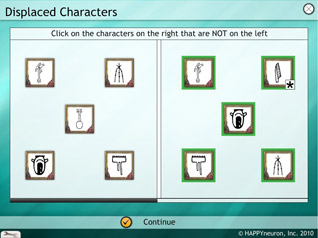
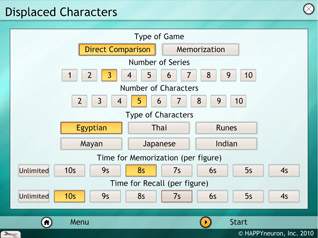
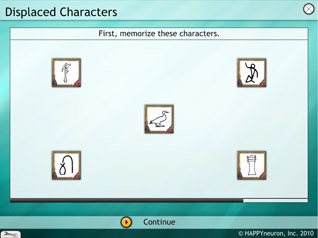
Displaced Characters
The task
In this exercise, the patient has to attentively observe figures in a list and select in a second list those figures that are not in the first list. At the beginning of the task, both lists will be on the same screen (direct comparison). They will later be on separate screens.
What it trains
This task helps the user to strengthen his visual and spatial perception and his memory by a process of distinguishing visual shapes and differences, as well as similarities amongst the characters. Memory is constantly called upon in varied ways such as to remember a pin code, a phone number, the title of a movie, an appointment, where you put your keys, or a historical event. Finally, this exercise also trains his concentration as he must pay attention to fine details in order to avoid confusion or omissions. Memory is needed everywhere in your daily life.
Parameters
A very high degree of control is available. The parameters that can be selected are the type of exercise (direct comparison or memorization), the number of sequenced series (1, 2, 3, 4, 5, 6, 7, 8, 9, or10), the number of characters (2, 3, 4, 5, 6, 7, 8, 9, or 10) and the type of characters (Egyptian, Thai, Runes, Mayan, Japanese, or Indian), the time for memorization per figure (unlimited, 10, 9, 8, 7, 6, 5, or 4 seconds), and the time for recall per figure (unlimited, 10, 9, 8, 7, 6, 5, or 4 seconds).
Number of Unique Configurations
Over 65,000 unique game configurations and significant data set depth.


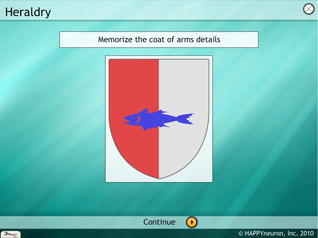


Heraldry
The task
The emergence of heraldry occurred across Western Europe almost simultaneously. Over time, distinct differences developed between the heraldic traditions of different countries. In this exercise, the patient is asked to memorize a coat of arms with all the elements that make it up. He therefore has to pay attention to shapes, colors, and patterns and to distinguish the various shields, tinctures, ordinaries, crests, and charges. The user will then be asked to recreate the coat of arms with its components.
What it trains
We rely on visual memory to remember the details of everything we see. Remembering city landmarks, recalling the logos on grocery products or bringing to mind the shapes of various traffic signs all entail use of this function. Spatial memory, by contrast, entails recalling objects in relation to one another; for example, locations on a map or the positions of stores in a shopping mall. This exercise therefore helps the patient strengthen his visual and spatial memory and perception as he has to explore and observe details of the coat of arms, link the components, and form a comprehensive mental image of the picture in order to recall it accurately. A further aim is to improve his visual attention and concentration skills.
Parameters
The parameters that can be selected are the number of coats of arms (1, 2, 3, 4, or 5), the level of difficulty (easy, medium, or hard), the time for memorization (unlimited, 120, 90, 60, 50, 40, or 30 seconds), the response time (unlimited, 120, 90, 60, 50, 40, or 30 seconds), and the modalities of the interference task (no interference, order numbers, or order words).
Number of Unique Configurations
Over 11,000 unique game configurations and significant data set depth.


Click to try FREE for 15-Days.
